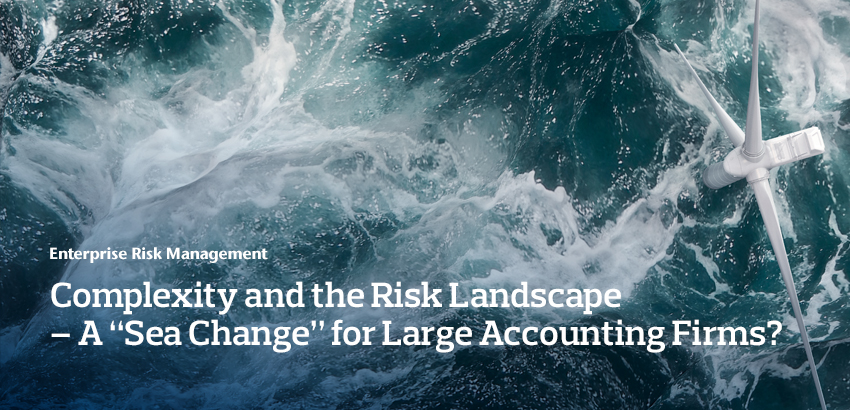Aon | Professional Services Practice
Complexity and the Risk Landscape – A “Sea Change” for Large Accounting Firms?
Release Date: December 2022 It was a great privilege to attend Swiss Re’s 14th Conference for Large Accounting Firms in October 2022, where many of the major risk trends facing the world today were discussed. Here are some takeaways from the event.
Introduction
The theme of the conference was, “Sea Change”. A fundamental question was explored: Are we living through a catastrophic rift, or is it a case of, this too will pass?
The discussions examined the interrelated nature of the threats that we face. As UN general secretary, Antonio Guterres recently observed, “Our world is in peril” and he set out the case for “Transformative solutions to interlocking challenges”.
These tectonic shifts, or Megatrends, go beyond issues routinely identified in risk surveys and encompass major economic, societal, environmental, and geopolitical movements, and the risks arising from them. Five such Megatrends are discussed in a PwC report the content of which was presented at the Conference: climate change, technological disruption, demographic shifts, a fracturing world, and social instability. These trends, and the crises that emerge from them, are the subject of Ten Years to Midnight, a book by Blair Sheppard* distributed at the Conference.
Debt, inflation, and fiscal pressures were discussed in a historical context, and the lessons explored. The question of resilience, for countries and organizations, was at the forefront.
The other major issue addressed was ESG, including from the perspectives of investors and insurance company operations. Legal, including litigation, and regulatory trends were examined.
We have recently written about the value of ERM in an environment of increasing uncertainty. The Conference did beg the question about how risk management recognizes and addresses these big threats.
Four Macro Risk Reflections
Here are four points on risk and uncertainty that emerged from the presentations.
- There is continuity with, and similarities to, past crises. Lessons exist that can be applied to today’s issues.
- Failures in global governance and cooperation are being exposed. Effective cooperation is required to address global problems.
- ESG must be defined for each organization and its components broken down. Organizations need to ask, what are the relevant components for us and what are the most material issues?
- Crises test societies and organizations. Decisions made in a crisis shape the future.
The Meaning for Risk Management?
In a different context in 1936, Keynes wrote about the “unforeseeable”:
Is that true about today’s uncertainties? What role can risk management play? Certainly, identifying threats and vulnerabilities is a good start.
ISO 31000 defines risk as “the effect of uncertainty on objectives.” The Megatrends, including the many facets of ESG, represent potential strategic threats and should therefore fall within the scope of the risk management function.
To achieve that, an expanded horizon of risk identification is necessary.
- Future hazards may be outside of a conventional and narrow risk identification exercise.
- There should be more attention to the interconnectivity of risks – pandemics, business interruption and cyber security, for example. Past data is potentially less valuable.
- Dislocation problems can be created by regulators and politicians. If the rules change, there may be unforeseen consequences.
Risk Management Responses?
There are shortcomings therefore to a narrow approach, hence the growth of the role of Chief Risk Officer. One is reminded of the VUCA acronym (Volatility, Uncertainty, Complexity, Ambiguity) that represents a mindset on how to approach dynamic and evolving problems.
Rigorous risk identification and assessment can offer a good defense against the impacts of unexpected disruptive events. What tools can be added to conventional risk identification and assessment?
- A PESTEL (Political, Economic, Social, Technological, Environmental, Legal) exercise could be valuable. A workshop can examine the risks, including vulnerabilities and consequences.
- A move to risk mapping that adopts a “Systems Thinking” approach, and charts the universe of internal and external risks, with their interdependencies.
- Scenario analysis is always a valuable tool.
- A multiskilled response is a critical success factor? It was suggested at the Swiss Re Conference that for building resilience, historians, political economists, and psychologists may have a place at the table.
Certainly, a conventional risk register has value, but it might represent a linear approach and needs to be supplemented by tools such as these to address today’s risk environment.
Final Thoughts
There is a heightened need to access risk intelligence and engage in dialogue such as that hosted by Swiss Re.
- Fundamental uncertainty will test resilience factors such as culture. Certainly, future ESG challenges are likely to manifest themselves in the fields of ethics and fundamental values.
- Complexity must be factored into the responses to big environmental and strategic risks. The quality of risk identification and assessment becomes crucial.
- Risk models and predictive analytics are tools that facilitate analysis and decision making. The numbers will not of course be precisely correct: “Prediction is very difficult, especially about the future”, as Neils Bohr observed.
- We are in a world where unexpected change has created significant and widespread disruptions. Pre-existing vulnerabilities can be compounded by dislocation following such changes.
Read other articles on Enterprise Risk Management.
Contact
The Professional Services Practice at Aon values your feedback. If you have any comments or questions, please contact Keith Tracey.
Keith Tracey
Managing Director
London
* Blair H. Sheppard, Ten Years to Midnight, (Berrett-Koehler, 2020), examines 5 crises; prosperity, technology, institutional legitimacy and leadership, and provides a framework for managing them.

